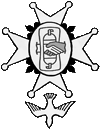AT THE START of the 20th century, the Pasteur was a French Canadian called Jean Barnabas. He served the church for nearly half a century. During his earlier years, he was a staunch, you might say fanatical, commemorator of the Catholic persecutions. He was instrumental in the construction of the memorial cross in Martyrs Field Road just outside Canterbury's city walls on the site of the stake at which so many Protestants met a terrible death.
When advancing age and infirmity overtook him, Barnabas was succeeded by Alfred Tucker, a Quaker teacher of French who courageously and diligently shepherded the church through the dark years of the Second World War until, in the late 1940s, he made way for Jean Garnier. Pasteur Garnier was born in Italy of Waldensian stock and grew up fluent in Italian and French. He learnt English in the early years of this century on arrival in Britain, where he met and married an English girl, whom he took to China to serve with him as a missionary for many years. In his retirement, after life as a missionary in China, Pasteur Garnier ministered to our church almost to his death in 1972.
His successor was Francois Dubois whose involvement with Canterbury, like that of his predecessor Joseph Martin exactly 100 years earlier, began when as Pasteur of the London Church he organised a team of visiting ministers and eventually became our full-time Pasteur. After association with our church for over 20 years, Francois Dubois retired at the age of 80.
Surely there have been very few, if any, clergymen in the city more widely respected, admired and loved. After a long life of ministry in northern France and England Pasteur Dubois died in 1995.
In 1991, Pasteur Hugh Boudin brought to our church an academic eminence, fluency in several languages and a facility with protocol and ceremonial, all coupled with amiable modesty, a kindly nature and good humour. During his decade here Hugh earned a very special place among the people of Canterbury and we are happy that, though retired to Brussels, he retains his links as our Pasteur Emeritus.
Hugh was succeeded by Pasteur Lusa Nsenga-Ngoy who was the youngest to have occupied the post for many years. Born in 1977 in the Democratic Republic of Congo (known at the time as Zaire), he moved in 1985 with his family to Belgium where his father is a Minister.
In 2000 Lusa took a degree as Licencié at the Faculty of Protestant Theology at Brussels University and he qualified as a teacher of Protestant religion. At Christ Church University Canterbury (2001-2002) Lusa obtained a diploma in European business, followed by a master's degree in Christian ethics at King's College London (2003-2004) and a post-graduate certificate in theology and ministry at Durham University (2007-2008).
Fluent in French and English, Lusa also speaks three African Languages. During his time in Canterbury Lusa established himself well in the church, the wider community of the cathedral and the city at large. His fine sermons generated warm praise. After six years as our Pasteur Lusa joined the ministry of the Church of England. Where he serves now as Bishop of Willesden.
Doubtless over the centuries, great, not to say invaluable, contributions to the welfare and continued existence of our church have been made by various lay people. Among the current generation, the 60 years' faithful service of Mona Green is unique. By her work for the church, her attendance and support, especially during the dark years of the Second World War and soon afterwards, Miss Green was a major factor in our church's survival.
The church records bear witness to the great and long-term commitment of past members such as Henry Ovenden, Raymond Matson and James Long whose overlapping years of service running from the start of the 20th century until the mid-eighties, aggregated about 150 years.
Our present congregation, by their active commitment, are ensuring that, well into its fifth century, the church is maintaining its perennial vigour and independence.
Michael H Peters
REFERENCES
- Minutes of Trustees and Consistory Meetings in the 19th century, in the keeping of the church
- The Antiquities of Canterbury, William Somner, 1640
- A Walk in and about the City of Canterbury, William Gostling, 1779
- The Crypt of Canterbury Cathedral, WA Scott Robertson, 1880
- Sketch of the History of the French Refugee Church of Canterbury, J A Martin, 1881
- History of the Walloon and Huguenot Church at Canterbury, Francis W Cross, 1898
- Mr Thomas Organ of the Cathedral Wallpainting Workshop
